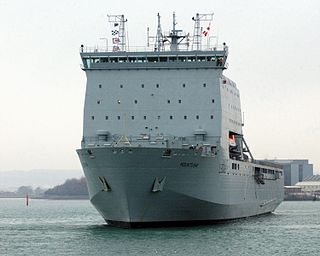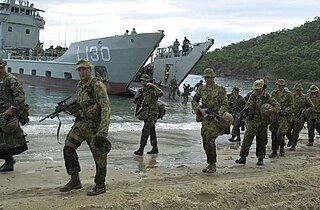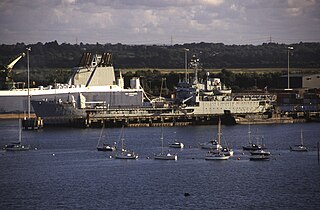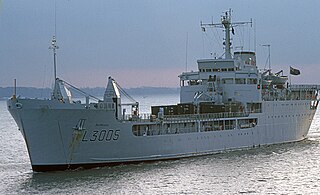
The Royal Fleet Auxiliary (RFA) is a naval auxiliary fleet owned by the UK's Ministry of Defence. It is a component of His Majesty's Naval Service and provides logistical and operational support to the Royal Navy and Royal Marines. The RFA ensures the Royal Navy is supplied and supported by providing fuel and stores through replenishment at sea, transporting Royal Marines and British Army personnel, providing medical care and transporting equipment and essentials around the world. In addition the RFA acts independently providing humanitarian aid, counter piracy and counter narcotic patrols together with assisting the Royal Navy in preventing conflict and securing international trade. They are a uniformed civilian branch of the Royal Navy staffed by British merchant sailors. The RFA is one of five RN fighting arms.

RFA Argus is a ship of the Royal Fleet Auxiliary operated by the Ministry of Defence under the Blue Ensign. Italian-built, Argus was formerly the container ship MVContender Bezant. The ship was requisitioned in 1982 for service in the Falklands War and purchased outright in 1984 for a four-year conversion to an Aviation Training Ship, replacing RFA Engadine. In 1991, during the Gulf War, she was fitted with an extensive and fully functional hospital to assume the additional role of Primary Casualty Receiving Ship. In 2009, the PCRS role became the ship's primary function. Argus is due to remain in service beyond 2030. In July 2022 it was reported that the future Littoral Strike Role would be assumed by Argus after a refit to convert her to this role. As of October 2023, Argus had started her deployment to serve as part of Littoral Response Group (South) based out of the UK Joint Logistics Support Base in Oman.

HMAS Choules (L100) is a Bay-class landing ship that served with the Royal Fleet Auxiliary (RFA) from 2006 to 2011, before being purchased by the Royal Australian Navy (RAN). The vessel was built as RFA Largs Bay by Swan Hunter in Wallsend, Tyne and Wear. She was named after Largs Bay in Ayrshire, Scotland, and entered service in November 2006. During her career with the RFA, Largs Bay served as the British ship assigned to patrol the Falkland Islands in 2008, and delivered relief supplies following the 2010 Haiti earthquake.

RFA Lyme Bay is a Bay-class auxiliary dock landing ship of the British Royal Fleet Auxiliary (RFA). Ordered from Swan Hunter in 2000, the ship was launched in 2005. However, cost overruns and delays saw the shipbuilder removed from the project, and the incomplete ship was towed to Govan for finishing by BAE Systems Naval Ships. Lyme Bay entered service in late 2007; the last ship of the class to join the RFA.

RFA Cardigan Bay is a Bay-class landing ship dock of the Royal Fleet Auxiliary (RFA). Built by BAE Systems, the ship was dedicated into the RFA at the end of 2006.

The Round Table class, also known as the Sir Lancelot class, was a British ship class designed for amphibious warfare missions in support of the main amphibious warfare ships. They were designated landing ship logistics (LSL). The class was almost certainly so named on account of the phonetic similarity between the abbreviation LSL and Lance-'S'-Lot.

The Bay class is a ship class of four dock landing ships built for the British Royal Fleet Auxiliary (RFA) during the 2000s. They are based on the Dutch-Spanish Royal Schelde Enforcer design, and replaced the Round Table-class logistics ships. Two ships each were ordered from Swan Hunter and BAE Systems Naval Ships. Construction work started in 2002, but saw major delays and cost overruns, particularly at Swan Hunter's shipyard. In mid-2006, Swan Hunter was stripped of work, and the incomplete second ship was towed to BAE's shipyard for completion. All four ships, Largs Bay, Lyme Bay, Mounts Bay, and Cardigan Bay had entered service by 2007.

Standing Royal Navy deployments is a list of operations and commitments undertaken by the United Kingdom's Royal Navy on a worldwide basis. The following list details these commitments and deployments sorted by region and in alphabetical order. Routine deployments made by the Navy's nuclear-powered submarines and their location of operations is classified.

His Majesty's Naval Service is the United Kingdom's naval warfare and maritime service. It consists of the Royal Navy, Royal Marines, Royal Fleet Auxiliary, Royal Naval Reserve, Royal Marines Reserve and Naval Careers Service. The Naval Service as a whole falls under the command of the Navy Board, which is headed by the First Sea Lord. This position is currently held by Admiral Sir Ben Key. The Defence Council delegates administration of the Naval Service to the Admiralty Board, chaired by the Secretary of State for Defence.

The Kanimbla class was a class of amphibious transport ships operated by the Royal Australian Navy (RAN). Two ships were purchased by Australia in 1994 and modified. Problems during the handover process and the need to repair previously unidentified defects meant the ships did not enter operational service until the end of the decade.

Claude Stanley Choules was an English-born military serviceman from Pershore, Worcestershire, who at the time of his death was the oldest combat veteran of the First World War from England, having served with the Royal Navy from 1915 until 1926. After having emigrated to Australia he served with the Royal Australian Navy, from 1926 until 1956, as a Chief Petty Officer and was a naturalised Australian citizen. He was the last surviving military witness to the scuttling of the German fleet in Scapa Flow in 1919 and the last surviving veteran to have served in both world wars. At the time of his death, he was the third-oldest verified military veteran in the world and the oldest known living man in Australia. He was the seventh-oldest living man in the world. Choules became the oldest man born in the United Kingdom following the death of Stanley Lucas on 21 June 2010. Choules died at the age of 110 years and 63 days. He had been the oldest British-born man; following his death, that honour went to Reverend Reginald Dean. In December 2011, the landing ship HMAS Choules was named after him, only the second Royal Australian Navy vessel named after a sailor.

The 1982 British military campaign to recapture the Falkland Islands depended on complex logistical arrangements. The logistical difficulties of operating 7,000 nautical miles from home were formidable. The Argentine invasion of the Falkland Islands came at a time when the Royal Navy was experiencing a reduction in its amphibious capability, but it still possessed the aircraft carriers HMS Hermes and Invincible, the landing platform dock (LPD) ships HMS Fearless and Intrepid, and six landing ship logistics (LSL) ships. To provide the necessary logistic support, the Royal Navy's ships were augmented by ships taken up from trade (STUFT).

The Royal Australian Navy and Australian Army have operated 29 amphibious warfare ships. These ships have been used to transport Army units and supplies during exercises and operational deployments.

Marchwood Military Port (MMP) or Marchwood Sea Mounting Centre (SMC) is a military port located in Marchwood, Southampton on the south coast of the UK, and the base of 17 Port & Maritime Regiment Royal Logistic Corps. The port was built in 1943 to aid in the D-Day assault on Normandy in 1944 and has since been used to support the Falklands War. The port is now used largely by the Royal Fleet Auxiliary, as a base for their ships, including the Tide-class tankers, and it is also still employed for military cargo and personnel movement.

17 Port and Maritime Regiment is a regiment of the British Army's Royal Logistic Corps. The unit is the Army's only regular Port & Maritime capability, though it is twinned with 165 Port and Maritime Regiment RLC, of the Army Reserve.

A rhino ferry is a barge constructed from several pontoons which are connected and equipped with outboard engines, used to transport heavy equipment and people. Rhino ferries were used extensively during the Normandy landings and other theaters ; their low draft was well-suited for shallow beaches, and they could also be used as piers when filled with water. An alternative to tank landing craft, they were operated by United States Navy Construction Battalions. They ferried their cargo from the outlying Landing Ships, Tank to the shore.





















